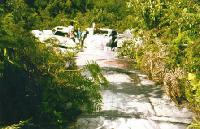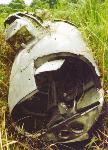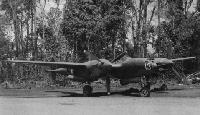Фотографии
-
B-17F 41-24381 'Panama Hattie' of the 63rd BS led B-17E 41-9234 to Lae for the January 8 attack.
Самолёты на фотографии: Boeing B-17E / B-17G Flying Fortress - США - 1941
-
Ray Dau's former ball turret gunner, Francis Caldwell, died when B-17E 41-2634 'Red Moose Express' was shot down over the sea while bombing Bogadjim. It is pictured at 7-Mile Airdrome.
Самолёты на фотографии: Boeing B-17E / B-17G Flying Fortress - США - 1941
-
B-17E 41-9193 'Gypsy Rose', the Fortress ditched by Ray Dau and Bill Sarsfield off the Papuan coast on May 24, 1943.
Самолёты на фотографии: Boeing B-17E / B-17G Flying Fortress - США - 1941
-
Photographed in its revetment at 7-Mile Airdrome, Port Moresby, in early 1943, B-17F 41-24455 ‘Old Baldy' was fiown by James Dieffendorfer during the pivotal Battle of the Bismarck Sea. On March 2, it lost the fabric from both elevators during a 280mph dive but Dieffendorfer managed to land safely at Port Moresby after a nerve-racking crossing of the Owen Stanley Range using the trim tabs to control pitch. 'Old Baldy’, named by the crew chief after a local peak in his native New Jersey, displays markings for 71 missions and at least three fighters and three vessels destroyed. The well-worn Fortress returned to the United States in November 1943, joining the 398th BG at Rapid City, South Dakota, as a trainer. It was written off on September 3,1944.
Самолёты на фотографии: Boeing B-17E / B-17G Flying Fortress - США - 1941
-
The Olive Drab upper finish, applied for service in the Pacific, has weathered away to reveal the Temperate Sea camouflage scheme and early Type A1 RAF roundels, applied prior to the intended delivery flight to the United Kingdom. Note the colour transition at the 11 o'clock position above the RAF roundel from what was Dark Slate Grey (left) to Extra Dark Sea Grey. The RAF fin flash and USAAF serial are visible on the fin.
Самолёты на фотографии: Boeing B-17E / B-17G Flying Fortress - США - 1941
-
Bruce Benson occupies co-pilot Donald Hoggan's seat in this 1977 view of the gutted cockpit. The starboard B-17F-style gun window can be seen below the windscreen centre frame member.
Самолёты на фотографии: Boeing B-17E / B-17G Flying Fortress - США - 1941
-
View of Fortress 41-9234 taken from 10,000 ft by a B-17 of the 8th Photo Reconnaissance Squadron on January 26, 1943. Note how soil piled up at the port wing root as the aircraft slid sideways.
Самолёты на фотографии: Boeing B-17E / B-17G Flying Fortress - США - 1941
-
View across Kaisenik Creek shows how pilot Ray Dau ran out of options as he wrestled to keep the Fortress in the air on two engines in rising terrain.
Самолёты на фотографии: Boeing B-17E / B-17G Flying Fortress - США - 1941
-
41-9234 sits in a tranquil field of kunai grass in August 1993. The large break in port side of the fuselage coincided with the forward end of the radio compartment where several of the crew were located during the crash landing. The RAF roundels are still visible on the wing and fuselage side.
Самолёты на фотографии: Boeing B-17E / B-17G Flying Fortress - США - 1941
-
Head-on view reveals that Ray Dau was alighting on rising ground. The aircraft arrived from the left, slewing 90 degrees to the right to reach its final position. Note that the mainplane and its attachment frames became twisted relative to the fuselage as the aircraft slid sideways uphill.
Самолёты на фотографии: Boeing B-17E / B-17G Flying Fortress - США - 1941
-
Port side of the fin still bearing USAAF serial 19234 and vestiges of the RAF fin flash. The Temperate Sea camouflage pattern is visible in the original slide as is RAF serial number FL461, just below the intersection of the panel lines in front of and underneath the leading edge of the horizontal stabiliser. Damage to the fin is the result of anti-aircraft fire and attacks by Japanese fighters. The missing panel in the fin fairing covered a lifting ring.
Самолёты на фотографии: Boeing B-17E / B-17G Flying Fortress - США - 1941
-
View from the port wing tip showing the exposed Type B RAF roundel. The heavy vegetation is shown in later photographs to have been burned away by brush fires.
Самолёты на фотографии: Boeing B-17E / B-17G Flying Fortress - США - 1941
-
The number 3 and 4 engines were rendered useless by flak over Lae but were allowed to windmill until the japanese fighters had withdrawn. Ray Dau succeeded in feathering number 3 but not, as can be seen from the angle of the severed blade, the outer engine. The main fin section has weathered to a red colour from the original Medium Green finish applied by Boeing's subcontractor.
Самолёты на фотографии: Boeing B-17E / B-17G Flying Fortress - США - 1941
-
Henry Bowen's tail gun position, separated from the rest of the airframe by souvenir hunters. The rear-facing armoured window is smashed, possibly by flak or a cannon shell, and at least four bullet holes are visible, one just above the armoured panel.
Самолёты на фотографии: Boeing B-17E / B-17G Flying Fortress - США - 1941
-
B-25C Mitchell 41-12898 of the 38th BG stalks its prey during January 7 attacks on the Lae Convoy. The puffs of smoke are exploding anti-aircraft shells.
Самолёты на фотографии: North American B-25 Mitchell / PBJ-1 - США - 1940
-
B-25D 41-29700 ‘Annette’ of the 71st BS, 38th BG, dives through bursts of flak as it attacks the Lae Convoy on January 7,1943.
Самолёты на фотографии: North American B-25 Mitchell / PBJ-1 - США - 1940
-
Ki.43-1 Hayabusa ‘Oscar’of the 11th Sentai at Lae following the airfield's capture. The yellow lightning bolt on the tail indicates that it was from 3rd Chutai while the broad fuselage band indicates it was probably the leader's aircraft.
Самолёты на фотографии: Nakajima Ki.43 Hayabusa - Япония - 1938
-
Регистрационный номер: A19-120 Australian-built Beaufighter 21s of 30 Squadron RAAF around the time of the Lae Convoy. Fg Off W George Robertson is flying the nearer aircraft, A19-120/‘LY-H’, with F/Sgt Rex Pitman as his navigator, while 'LY-T' is being flown by Pit Off Robert Walker with navigator Pit Off James Howell, Beaufighters were used to devastating affect during the Lae and Bismarck Sea convoy operations, strafing airfields and ship-borne anti-aircraft positions.
Самолёты на фотографии: Bristol Beaufighter - Великобритания - 1939
-
Derelict A6M3 Zero-Sen Model 32 (s/n 3268) '2-152' of 582 Kokutai, photographed at Lae airfield following its capture by US forces in September 1943. Note the distinctive clipped-wing configuration of the naval Hamp.
Самолёты на фотографии: Mitsubishi A6M Reisen - Япония - 1939
-
Unidentified Lockheed P-38F Lightning '13' of the 39th FS, 35th FG at Dobodura.
Самолёты на фотографии: Lockheed P-38 Lightning - США - 1939
-
B-26 Marauder 40-1552 ‘Rose of San Antone' during a bombing run the Lae Convoy; the Japanese-held Lae airfield is visible to the rear. The attack took place at 2:30pm on January 8, about two hours after Fortress 41-9234 arrived over the convoy.
Самолёты на фотографии: Martin B-26 Marauder / Type 179 - США - 1940
-
B-26 Marauder 40-1498 of the 19th BS, 22nd BG crashed at 14-Mile Airdrome, Port Moresby on January 8, 1943, when a tyre blew out as it took off to attack the Lae Convoy. The pilot was Capt Willis C Bumgarner.
Самолёты на фотографии: Martin B-26 Marauder / Type 179 - США - 1940
-
Hudsons of 1 OTV, RAAF, at Wau airstrip on either January 8, 1942, the day of the B-17's crash-landing, or January 10, the day of the rescue mission. Note the steep downward slope of the airstrip behind the aircraft and that the engines have been left running for a quick departure.
Самолёты на фотографии: Lockheed Hudson A-28 / A-29 - США - 1938
Статьи
- Round-Out
- A.Pelletier - End of the Dinosaurs
- A.Thomas - Baltic Gladiators
- C.Justo - Auspicious Auster
- D.Darbyshire - Bobby's 'Aunties'
- G.Jones - Alpine Trainer
- G.Warner - From Bombay to Bombardier (2)
- J.Grant - Sacrificed to the God of Progress
- J.Zichek - 'Unknown' North Americans
- R.Stitt, J.Olsen - Brothers-in-Arms
- T.Buttler - 'Super Mirages'. France's quest for a future fighter
- Y.Gordon, A.Dawes - In the Line of Fire (1)






















